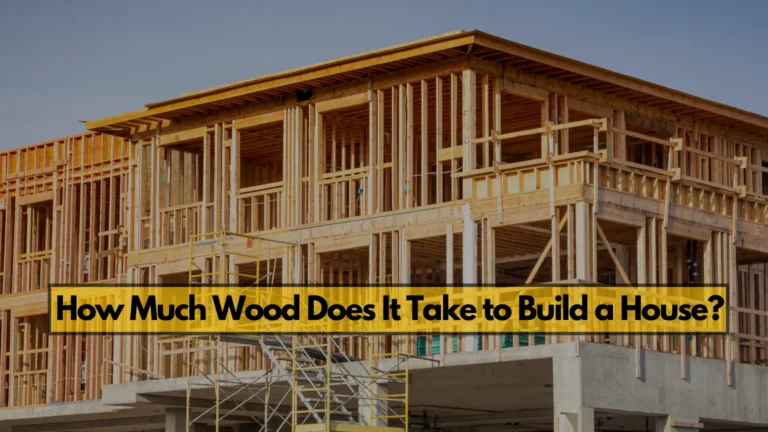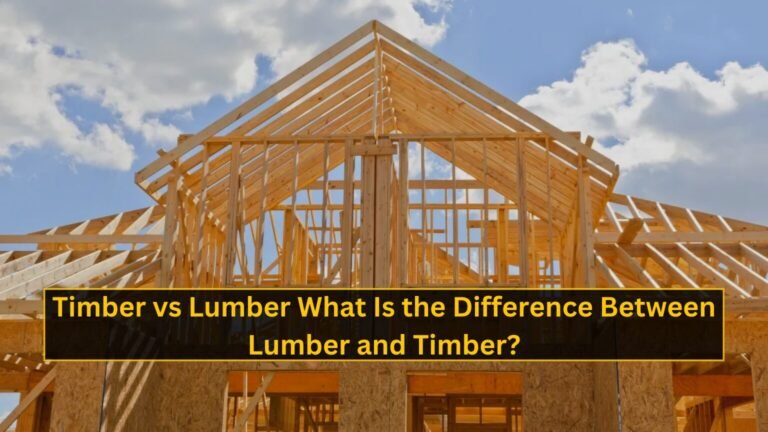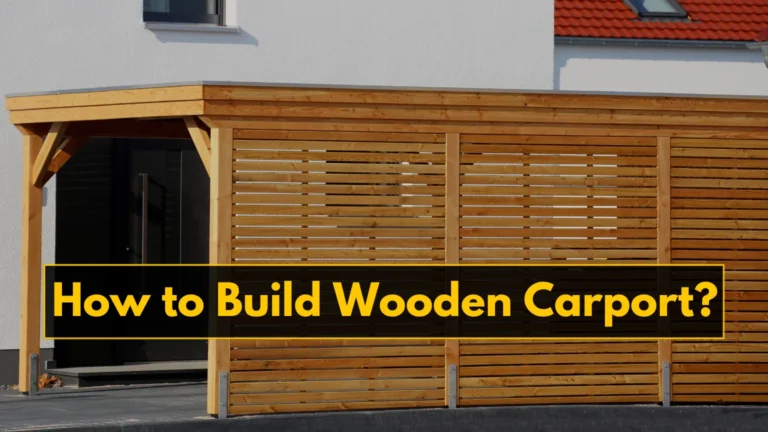Why Are American Houses Made of Wood?
American houses are primarily constructed from hardwoods; this decision is based on historical, economic, and practical reasons. The reasons for using wood date back centuries, when most settlers settled on the amount of timber available in North America. Over time, the advantages of wood have come up and thus remained the most frequently used in home building, even during modern times. Wood is still the best despite other alternatives, such as brick, steel, and concrete. The article delves into some of the reasons why wood has been put to such great use: its availability and historical, environmental, economic, and aesthetic advantages. The underlying reasons that make wood the preferred material help explain why it is a central component of today’s housing industry.
Historical Background of Using Wood in Construction
Wood has been used as a building material in America since its colonial days. Early American colonists had little access to stone or brick but were surrounded by rich forests that provided abundant timber. In the early stages of American settlement, European settlers adapted traditional timber framing techniques to local conditions. Brick and stone buildings were standard in Europe, but the New World relied more on wood. The ease of harvesting timber and building with simple tools helped the colonists build homes efficiently and affordably.
Westward Expansion and Wood as a Building Material
As America expanded westward, there was a growing need for quick and affordable housing. Wood became the material of choice for building homes. Innovations such as balloon framing and platform framing made building easier with wood, allowing for faster construction and grander housing developments. These methods were instrumental in the rapid growth of American cities and towns.
The Role of Abundant Timber Resources in America
The vast forests covering the United States, especially the Pacific Northwest, the Great Lakes, and the Appalachian Mountains, provide a natural and abundant timber supply. The United States is among the world’s largest wood producers, and this resource is locally sourced, reducing transportation costs and allowing builders to obtain timber more affordably.
Historically, early settlers often relied on the abundance of local forests by using wood for homes and agricultural structures like barns and fences.
Currently, timber supplied from responsible operations in sustainably managed forests ensures the regeneration of the country’s woods and continues to yield supplies for the following generations. Given the sustainability of wood exploitation, residential housing construction trends significantly favour timber use, not just because wood happens to abound. However, with new management responsibilities coming into sustainable timber harvesting, wooden material has become handy for those setting up residential shelters in the country during the Western influx.
Western Expansion and Wood as a Building Material
With America’s westward expansion, people needed affordable housing that was cheap and fast to construct. Therefore, wood was mainly used for construction purposes. Advances such as balloon framing and platform framing made the building process much more straightforward with Woo, as they could help in rapid production and the construction of larger housing projects. This brought about the rapid development of cities and towns in America.
Early Years and Benefits of Settlers
The earliest years of American settlement were the most evident use of wood because it was abundant. During this period, the settlers could harvest trees, process the timber with minimal tools, and quickly build homes with minimal cost and efficiency. Timber acquisition was inexpensive compared to other materials that involved transportation from a distant location.
With the country’s westward expansion, sawmills and railroad systems further increased timber accessibility. This made wood readily available and cheaper, and it continued to be used in construction.
Environmental Benefits of Using Wood
Due to rising environmental issues, wood is highly valued because it is environmentally friendly. Wood is a renewable source of energy and offers other ecological benefits.

Sustainability and Renewable Resources
Wood is one of the few genuinely renewable building materials. Unlike concrete or steel, it draws upon non-renewable resources, whereas timber can be certified as sustainably harvested, which allows forests to replenish themselves. The United States has worked very hard to ensure its forests are managed responsibly, given high regard to replanting and conservation practices.
Carbon Sequestration
Wood also helps reduce carbon emissions. Trees absorb and store carbon dioxide from the atmosphere, thus acting as carbon sinks. When used in construction, wood stores this carbon over the lifetime of the building, reducing the overall carbon footprint. In contrast, the production of concrete and steel releases large amounts of CO2 into the atmosphere.
Energy Efficiency of Wooden Homes
Wooden houses are generally more energy-efficient than most buildings. Their insulating properties naturally keep the house warm, reducing the use of heating and cooling. This reduces energy consumption, saves homeowner’s utility bills, and helps conserve the environment.
Reuse and Recycle of Wood
The idea of a circular economy is supported by wood because wood can be recycled or reused once the life cycle of a building is over. Unlike materials contributing to the generation of a great deal of waste in landfills, wood is reused for other building materials or mulched or converted into different products that are much more sustainable in the long run.
Benefits of Wood in Construction
Wood has various unique properties, providing several benefits during construction that are ideal for US residential projects. Let’s discuss those advantages in more detail.
Construction Cost Effectiveness
Wood is one of the most affordable building materials available. Compared to other alternatives, such as concrete, steel, or brick, lumber is cheaper in terms of material and labour costs. Wood’s relative affordability allows builders to construct homes at a lower cost, keeping housing prices low. Lower material costs benefit construction projections, making wood a go-to option for residential developments.
Design Flexibility
Wood provides a high degree of design flexibility to enable a style range from rustic to modern. It can absorb any stain, paint, and finishes, making the wood fit a design perfectly. This aesthetic ability is the biggest reason why wood is the popular choice of material for most house owners when it comes to house building. Wood will fit the vision regardless of whether it is used in framing, sidings, or interior design. Lumber take-off services ensure appropriate materials are available for these types of designs, with fewer materials taken to the construction sites, making the work process much more efficient and cost-effective.
Flexibility and Ease in Modification
Woodwork is very adaptable as compared with other building commodities. It would be easier to cut, shape or even change without affecting its entire shape, considering this aspect helps when a need arises to alter something.
Strength and Long Time Resistance
Although lightweight, wood can be very structurally strong when appropriately applied. With modern engineering techniques, wood can quickly meet the same durability standards as steel or concrete when used in the proper context. It is an excellent material for residential homes, especially with modern construction methods like platform framing.
Labor and Construction Efficiency
Yet another reason why wood is preferred for house building in the United States is that it benefits labour costs and completion time. Wood can be handled relatively more quickly than most other materials used in construction, like steel or concrete, which need specialised manpower and equipment to be used properly. Builders can saw, shape, and fit wooden beams, studs, and trusses almost with haste and speed up the completion of any home.
Economic Benefits
Besides the construction benefits, wood provides several economic advantages, making it a popular choice for residential builders.
Wood is Affordable
The availability of timber in the United States makes wood a cheap material for establishing projects. The cost of materials when building with wood is usually less than when constructing with steel, brick, or concrete. This means less overreaching costs of construction made of wood, and homes can be built faster and cheaper.
Long-Term Savings
Wooden houses also offer long-term economic benefits. Their insulating properties help reduce energy costs and provide substantial savings on heating and cooling bills over the life of the house. Wood is also more manageable and less expensive to repair than brick or stone, thus saving homeowners money in the long term.
Speed up Construction
One of the main reasons wood remains the material of choice for residential homes is its speed of assembly. Unlike concrete or steel, which require specialised equipment and longer curing times, wood can be worked with relatively simple tools and assembled quickly.
This short construction period saves labour costs and provides the completion of projects on time. Takeoff services for timber are highly required here since they offer the exact amount of wood needed and allow the project to be conducted in a smooth manner without interrupting it with a lack of material.
Aesthetics Benefits of Wooden Houses
In addition to the above advantages, wooden houses have significant aesthetic advantages that make them attractive to dwellers.

Design flexibility
Woods offers flexibility in terms of design and can be easily used for different architectural styles. Wood can be made to fit in with a traditional cottage, modern minimalist home, or rustic cabin. This flexibility in wood makes creating personalised homes reflecting the homeowner’s vision easier.
Aesthetic Appeal
Wood gives a house warmth and beauty that no other material can reproduce. Its texture, grain, and colour provide a room character, whether through exposed beams, wooden flooring, or natural wood siding. This aesthetic quality gives wooden homes an exclusive charm that no other materials can provide.
Customisation Options
Wood also allows greater customisation. Homeowners may stain, paint, or leave wood unfinished to suit their style, and it can be carved or shaped to such intricate designs. It is perfect for creating a living space according to one’s taste.
Why Alternatives Haven’t Taken Over?
Wood remains the preferred building material for many American homes despite the increased popularity of alternative building materials. This is attributed to several factors, including the cost of alternatives and the cultural legacy of wooden houses.
Cost Barriers of Alternatives
These include other raw materials, such as concrete and steel, which are expensive to manufacture and often require specialised labour for fitting. The cost of resource acquisition, preparation, and handling of these materials discourages home construction as they are costly and unaffordable.
Cultural and History Significance
Wood has a profound cultural and historical significance to American architecture. It has represented warmth, comfort, and tradition in homes for centuries. This cultural connotation, coupled with wood’s practicality, ensures that it remains atop the list of choices for home building in America.
Wood in Modern Architecture: A New Wave of Innovation
Wood continues to thrive in modern American housing despite being an ancient material. New technologies and construction methods, such as cross-laminated timber (CLT), allow wood to be used in larger, more complex structures. CLT is an engineered wood product that’s stronger and more fire-resistant than traditional wood, making it suitable for taller buildings and commercial structures.
The increase in green buildings has also added to their trend. Owners and builders want less harmful environmental effects materials, and wood fits this requirement. With increased interest in carbon footprints, wood seems to be one of the substitutes to minimise home construction’s carbon footprint.
The Future of Wood in American Homes
Wood looks pretty secure in its role in American housing, but the future will likely witness even more innovations. The evolving nature of building materials makes engineered wood in newer forms like CLT even more common in residential and commercial buildings. Such innovations will allow wood to meet the requirements of modern architecture while keeping sustainability and eco-friendly properties intact. As people become more aware of their ecological footprint, sustainable homes will only continue to rise in demand. Wood, as an asable and carbon sink, will play an essential role in this change in greener building practices.
Conclusion
American houses are built from wood for several practical, environmental, economic, and aesthetic reasons. The reasons are the availability of wood, the fact that it is renewable, the history of wooden houses, and the fact that there is much training on the use of wood. Regardless of its more renewable nature, capacity to reduce construction costs or aesthetic flexibility, wood seems to be the bedrock of American residential construction. As the eventual concerns continue rising, wood’s utility in the form of environmentally friendly, energy-efficient homes strengthens its position in construction for the future.

Tony Cummins began his career as a carpenter in a sawmill, where he learned the ins and outs of cutting and processing wood. Over the years, he honed his skills and gained vast knowledge about different types of lumber and their uses. After many years of working directly in the industry, he decided to start his company for preparing lumber takeoffs to help contractors.
















